Expanding Opportunities for Yogurt
INGREDIENTS
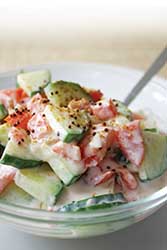 The origin of yogurt dates back thousands of years, with some researchers thinking that this first yogurt resulted from the unintended fermentation of milk. While still basically fermented milk, today's yogurt available in grocery stores is, of course, a much different product from many years ago. Consumers can enjoy a wide variety of flavors, both sweet and savory, experience a range of textures, and even drink yogurt from a bottle or squeeze it from a pouch.
The origin of yogurt dates back thousands of years, with some researchers thinking that this first yogurt resulted from the unintended fermentation of milk. While still basically fermented milk, today's yogurt available in grocery stores is, of course, a much different product from many years ago. Consumers can enjoy a wide variety of flavors, both sweet and savory, experience a range of textures, and even drink yogurt from a bottle or squeeze it from a pouch.
Yogurt is an increasingly popular food, with 2013 marking the fifth consecutive year of growth, according to market research firm Mintel (Mintel, 2013). At press time, Mintel estimated sales of yogurt to be about $7.4 billion in 2013, and the research firm predicts that yogurt sales could reach $9 billion by 2018 due in part to continued consumer demand for healthier snack alternatives and consumer interest in new varieties and brands of Greek yogurt products.
The driving force behind the sales growth is most notably from growing consumer demand for Greek yogurt products. Greek yogurt manufacturer Chobani posted sales of more than $1 billion, and Dannon's Oikos Greek yogurt brand saw sales increase 164.7% during the 52 weeks ending May 19, 2013, reports Mintel.
One interesting note is that while sales of Greek yogurt are driving the overall sales of yogurt, it is mainly more affluent consumers with household incomes greater than $100,000 and those with household incomes in the $70,000-$90,000 range who are purchasing Greek yogurt—and paying a 35% price premium, according to Todd Hale, Senior Vice President, Consumer & Shopper Insights at Nielsen, who presented a session about Greek yogurt at the 2013 International Dairy Foods Association International Dairy Show. "It's a premium product winning at a tough time because it's connecting with consumers who can afford to spend."
Yogurt offers a number of health benefits such as probiotics and protein, and many consumers point to yogurt's health benefits as a reason for purchasing yogurt, according to Mintel. There is a heightened awareness of increasing protein in the diet. Everyone from consumers to those who work in the food industry, including product developers and nutritionists, is looking for ways to add sources of protein to meals and snacks. Greek yogurt contains more than twice the amount of protein than non-Greek yogurt, and this protein claim is another factor in the product's success, Hale mentioned in his presentation. But he warned that this may not be enough to sustain growth; yogurt manufacturers, specifically those who produce Greek yogurt, need to continue to innovate to connect with all shoppers.
For product developers and manufacturers, there is no shortage of ways to innovate. It means offering a new range of flavors, experimenting with different textures, bringing excitement to the product with novel packaging sizes and formats, promoting yogurt as a food that can be eaten for any meal during the day, and using yogurt as an ingredient for other foods like sauces and dips or the flavor of yogurt for coatings and confections. There is also an opportunity to draw inspiration from cuisines around the world. For example, yogurt is used as an ingredient in some curry dishes and sauces in Indian cuisine. Finally, yogurt manufacturers and retailers can collaborate to develop and market new yogurt products as Danone and Starbucks Coffee Co. are doing. Their agreement involves jointly creating and developing a portfolio of Evolution Fresh, Inspired by Dannon branded ready-to-eat parfait Greek yogurt products for exclusive distribution in U.S. Starbucks stores beginning in 2014 and grocery stores in 2015. This article explains some of the ways ingredients manufacturers are helping product developers innovate in the yogurt category and look for new culinary and consumer packaged goods applications for yogurt.
--- PAGE BREAK ---
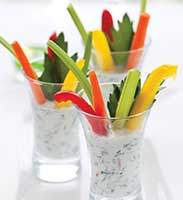 Maintaining a Stable Gel
Maintaining a Stable Gel
"Many hydrocolloids that function as thickeners and gel enhancers will also function in moisture management and help prevent syneresis," says Donna Klockeman, Senior Principal Food Scientist at TIC Gums Inc., White Marsh, Md. (www.ticgums.com). "All together with the dairy ingredients, hydrocolloid systems function to deliver texture and stability to yogurt (traditional, Greek-style, and drinkable) and fruit preparations."
The TIC Gums portfolio of hydrocolloid ingredients consists of ones that address texture and stability solutions for the dairy industry, including yogurt manufacturers. Consumers now have a choice of new yogurt products that target texture expectations of different ethnic groups of consumers and are based on products available in other parts of the world, explains Klockeman. TIC Gums has customers looking for a range of textures for their yogurt products based on what consumers want and what the product types are, she adds, so TIC Gums offers stabilizer systems based on ingredient requirements, product processing, formulations, and target texture that provide thickening and gelling texture attributes and manage moisture.
The dairy cases at grocery stores are filled with Greek yogurt options that appeal to a wide range of consumers, and market researchers have noted that sales in the Greek yogurt category continue to increase. "There is no doubt that Greek-style yogurt has changed the yogurt category in the U.S.," states Klockeman. "It has brought new consumers to cultured dairy products and enhanced the view of yogurt as a good source of high-quality protein." Its popularity as a food has helped it to move into use as an ingredient in culinary applications and other consumer packaged goods product categories like frozen desserts, beverages, salad dressing, dips, and some baked goods. When using yogurt as an ingredient, product developers need to have an understanding of the properties of the yogurt ingredient and the finished product in which the yogurt will be formulated, and the processing methods used, as differences in sugar, moisture, and protein content of the yogurt can affect the performance in applications, explains Klockeman. TIC Gums demonstrated an on-trend application using Greek yogurt as an ingredient in a cold-processed cucumber dill dip at the 2013 International Dairy Foods Association International Dairy Show. The dip was made from a non-fat strained Greek yogurt, sour cream, salt, spice, and the company's Dairyblend YG DP-2 stabilizer system, which provided thickness, improved spreadability, and controlled syneresis.
The food technologists at Gum Technology, Tucson, Ariz. (www.gumtech.com), continually develop hydrocolloid stabilizing systems consisting of combinations of gums, gums and starches, and gums and fibers to help product developers with formulation issues related to texture and other product attributes. The company's Coyote Fi™ ST-0308 stabilizing system of soy fiber and tara gum is said to help prevent protein precipitation and reduce gritty texture in frozen yogurt. An added benefit of the ingredient when used in frozen yogurt and drinkable yogurt is that it can protect the dairy proteins in acidic environments like ones in which fruit or other acidic components are added. Ingredients like this combine the desired attributes of specific gums and starches to solve challenges that product developers of yogurt face like syneresis or poor mouthfeel. They are also beneficial to product developers looking to improve texture and explore new textural attributes for different types of yogurt products.
--- PAGE BREAK ---
Using Starches to Improve Texture
Removing some or all of the fat from yogurt affects the textural aspects of the product, and starch and starch-based ingredients can help product developers formulate low-fat and 0% fat yogurt with very good fat mimetic properties and mouthfeel, says Ivan Gonzales, Marketing Director for the dairy segment at Ingredion Inc., Westchester, Ill (www.ingredion.com, www.foodinnovation.com). His colleague, Senthil Ganesh, Senior Applications Associate, who works on developing ingredient solutions for various dairy products, adds that ingredients like the company's PRECISA™ provide the creaminess and the eating experience equal to full-fat stirred yogurt.
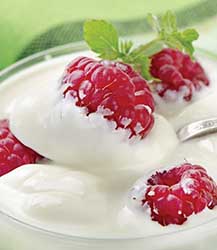 Their work is not only about improving the texture of low-fat and 0% fat yogurt; they are also helping their customers develop yogurts with thicker textures similar to Greek yogurt or their targeted texture based on what their consumers want, working on ingredient solutions that allow manufacturers to add different inclusions without negatively affecting the overall finished yogurt product, staying on top of the latest culinary trends, and even experimenting with different starches to create something new. "We have some ingredients that can provide unique and novel textures," states Ganesh. He cited a yogurt product concept for children that has a gelled texture with a "wiggly" appearance.
Their work is not only about improving the texture of low-fat and 0% fat yogurt; they are also helping their customers develop yogurts with thicker textures similar to Greek yogurt or their targeted texture based on what their consumers want, working on ingredient solutions that allow manufacturers to add different inclusions without negatively affecting the overall finished yogurt product, staying on top of the latest culinary trends, and even experimenting with different starches to create something new. "We have some ingredients that can provide unique and novel textures," states Ganesh. He cited a yogurt product concept for children that has a gelled texture with a "wiggly" appearance.
Another area of focus is developing ingredients that provide indulgent or dessert-like textures to yogurt. Ingredion's NOVATION® Indulge 3320 gelling starch system was used in Greek-style yogurt served at the company's yogurt bar during the 2013 IFT Annual Meeting & Food Expo. Attendees were able to choose from a variety of sweet and savory toppings like sour cherry balsamic compote, vegetable and tofu curry, pomegranate basil sauce with pignoli cookie crumble, reduced-sugar strawberry–lemon–ginger sauce and lemon granola topping, and pink grapefruit-flavored honey syrup and fresh mint developed by the Ingredion team of culinary experts, who stay up to date on the latest trends and emerging issues related to yogurt, adds Gonzales. "We are being challenged by the industry. They want to bring the texture experience into yogurt." NOVATION Indulge 3320 is said to help to build back or improve the gel strength of yogurt, have good cold temperature stability, control the viscosity of the final yogurt product, inhibit syneresis, and provide a smooth, creamy texture to the yogurt even after prolonged storage. It can be labeled as "maltodextrin, tapioca starch."
Several years ago, the company did a global yogurt category appraisal and found that there was a combination of certain textural attributes related to firmness in the mouth, meltaway, and mouthcoating, how the yogurt product clears away in the mouth, and flow characteristics that constituted the preferred texture, says Ganesh. Gonzales adds that with the introduction of Greek yogurt in the U.S. market, there is a shift in terms of what attributes are being preferred by consumers now, changing from a custard-like texture to one that is thicker. And now, he says, the work is determining what will be the next Greek yogurt and developing new ingredients and technologies to help deliver the products and desired textures.
A potato-based, soluble resistant starch ingredient can help to reduce calories by partially replacing sugar in drinkable and spoonable yogurt products. While the ingredient, PenFibe® RO from Penford Food Ingredients, Centennial, Colo. (www.penford.com), made its debut at the International Baking Industry Exposition (IBIE) 2013, where its functionalities in bakery applications were highlighted, Penford does recommend the use of the ingredient in dairy applications like yogurt. PenFibe RO contains a minimum of 56% dietary fiber so it provides fiber enrichment. John Randall, President of Penford Food Ingredients, remarked at the time of the ingredient's debut in October 2013 that the demand for healthy snacks and beverages continues to rise, especially for those products marketed to children, and that PenFibe RO's benefits can help manufacturers develop healthier options. The company cites other benefits of the ingredient beyond sugar reduction and fiber enhancement. These include neutral taste, cold stability, pH stability, texturizing and good gut tolerance.
Whey separation during the distribution and storage of set and stirred yogurts can be a problem for manufacturers. At the 2013 IFT Annual Meeting & Food Expo, Palsgaard A/S, Juelsminde, Denmark (www.palsgaard.com), introduced a stabilizer blend that it says can help to prevent whey separation and produce a smooth and creamy consistency and firm texture in stirred yogurt products made from fresh milk. The ingredient, Palsgaard® AcidMilk 316, is a blend of native starch and citrus fibers, making it an attractive ingredient to use in yogurts that offer a clean label, remarks Rosa Regalado, General Manager at Palsgaard. More importantly, the company reports that the ingredient does not contain the allergens wheat, crustacean shellfish, egg, fish, peanuts, soybeans, milk, or tree nuts.
The Palsgaard AcidMilk 316 ingredient is simple to incorporate into the formulation; just sprinkle it into milk while stirring right before pasteurization, homogenization, and fermentation. The recommended usage levels are 0.6-1.0% for standard yogurt made with whole milk and 0.8-1.2% for low-fat yogurt made with skim milk, although these amounts can vary depending on the composition of the yogurt and the texture desired.
--- PAGE BREAK ---
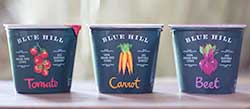 The Savory Side of Yogurt
The Savory Side of Yogurt
Savory options for yogurt are piquing the interest of some consumers who want something beyond the sweet, dessert-like, often fruit-flavored varieties available in supermarkets. Some of the toppings for yogurt developed by Ingredion's culinary team mentioned earlier in this article illustrate the savory yogurt concept. Blue Hill Farm (www.bluehillyogurt.com) recently introduced six yogurt varieties made with vegetables that appeal to those consumers looking for yogurt with subtle savory notes. The Blue Hill yogurt flavors include carrot, sweet potato, beet, butternut squash, tomato, and parsnip, vegetables that naturally have higher sugar contents. The company promotes the yogurts as being a little savory but also a little sweet. The butternut squash variety, for example, is made from pasteurized whole milk, roasted butternut squash, fresh sage, sea salt, maple sugar, cinnamon, nutmeg, clove, and live active cultures. The tomato variety includes pasteurized whole milk, tomatoes, red onion, honey, maple syrup, sea salt, ginger puree, lemongrass, maple sugar, vanilla extract, white pepper, and live active cultures, and the beet variety contains pasteurized whole milk, roasted beets, honey, raspberry vinegar, beet juice concentrate, sea salt, and live active cultures. The company offers several recipes that use the yogurts as ingredients; examples include minted carrot and cabbage slaw, roasted beet and yogurt soup, and sweet potato cheesecake. The yogurts are available at select Whole Foods Markets and specialty grocers in the Northeast, but the company does have plans to expand into new markets.
At the Chobani retail store, Chobani Soho, in New York (chobanisoho.com), consumers can order yogurt in savory combinations like smoked salmon and dill and cucumber and olive oil. The Mediterranean yogurt bar at Chobani Soho, which opened in July 2012, also serves sweet versions like peanut butter and jelly, pistachio and chocolate, and toasted coconut and pineapple for people with a sweet tooth. Another New York-based establishment, Sohha Savory Yogurt (www.sohhayogurt.com), features yogurt topped with beets, walnut, and extra virgin olive oil (Beets Melody), cherry tomatoes, basil, and extra virgin olive oil (Caprese Salad), roasted pine nuts, poppy seed, sesame seed, garlic, and onion (Everything Bagel), and thyme, sumac, extra virgin olive oil, and olives (Za'atar Bliss). The ingredients take inspiration from Mediterranean cuisine, specifically Lebanon, where the company's owner and founder was raised as a child. On Stonyfield Farm Inc.'s website (www.stonyfield.com), suggestions for savory toppings for yogurt are given and include combinations like cucumber, fresh mint, and sea salt, garbanzo beans, grilled vegetables, and feta cheese, shredded beets, orange, and dill, and salsa and black beans.
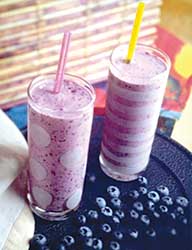 Enzyme Firms Pectin in Fruit Inclusions
Enzyme Firms Pectin in Fruit Inclusions
Many of the top flavor launches of spoonable yogurt in 2013 feature fruit like strawberry, blueberry, peach, pineapple, cherry, and mango, according to Mintel GNPD. Blueberries, strawberries, and other fruit add flavor and sweetness, texture, visual appeal, color, and nutrition to spoonable yogurts and are often incorporated as fruit preparations. Blueberries, for example, are naturally high in sugar and can help to temper some of the sour notes associated with yogurt, reports the U.S. Highbush Blueberry Council, Folsom, Calif. (www.blueberry.org). Of course, none of this matters if the fruit inclusions cannot withstand the rigors of processing. That is why Biocatalysts Ltd., Cardiff, Wales, UK (www.biocatalysts.com), developed a new fruit-firming enzyme Pectinase 872L, which was released at the 2013 IFT Annual Meeting & Food Expo.
The liquid enzyme works by catalyzing the hydrolysis of methyl ester bonds in pectin, which releases free carboxyl groups. Then the free carboxyl groups cross-link with divalent ions such as calcium to form a network of pectin, which is more likely to remain in the fruit tissue during processing. In other words, the enzyme helps transform soluble pectin into pectin that is much less soluble, according to the company. The result is fruit pieces that hold their texture in yogurt. The enzyme can be used on any soft fruit or vegetable that will be processed into fruit preparations, yogurt, jams, sauces, and more. The amount of Pectinase 872L used in a formulation depends on the type of fruit or vegetable and the processing conditions. It functions in a pH range of 4–5.
Dairy Proteins Solve Functionality Challenges
To help improve the shelf life of yogurt, manufacturers add gums, gelatins, pectin, and starches to bind water, which prevents syneresis and loss of gel structure. Regulations in different countries dictate how much of these stabilizing ingredients can be added to yogurt. Stirred yogurt needs more stabilizing and viscosity building beyond what the maximum allowed amounts of the stabilizers can provide so product developers formulate with various dairy proteins, which can provide a stabilizer-type function in yogurt, according to Idaho Milk Products, Jerome, Idaho (www.idahomilkproducts.com).
--- PAGE BREAK ---
Some of the more commonly used dairy proteins in yogurt products are milk protein concentrate (MPC) and milk protein isolate (MPI) with the use of whey protein concentrate (WPC) and whey protein isolate (WPI) being explored more, according to the U.S. Dairy Export Council, Arlington, Va. (www.usdec.org) (USDEC, 2009). Idaho Milk Products specializes in developing milk proteins like MPC, which it reports binds water well, helping to stabilize the yogurt gel, and has the same protein ratio as the milk used to produce the yogurt, so it will not change the yogurt gel texture. When used at appropriate levels, MPC will not cause the yogurt to have a gummy, custard-like, or pudding-like texture, but when too much is used, it can result in a grainy texture because the casein in MPC is not stable in acidic environments. Whey proteins bind water by forming thermo-irreversible gels after heat treatment denatures them, although they do not bind as much water as milk proteins, and they produce yogurt with a smooth mouthfeel when not used in excess. The functional properties of emulsification, gelation, visual appeal, and whipping ability/foaming make whey proteins useful in products like aerated yogurt, yogurt smoothie beverages, and squeeze-tube yogurt where these properties are needed, according to the U.S. Dairy Export Council.
At the 2013 International Dairy Foods Association International Dairy Show, Glanbia Nutritionals Inc., Evanston, Ill. (www.glanbianutritionals.com), showcased some of its dairy-derived proteins in yogurt applications to demonstrate how the ingredients can boost the protein levels and provide desired textures and mouthfeel to the products. The first ingredient, OptiSol ® 1020 milk protein concentrate was shown in an on-trend product, caramel-flavored Greek yogurt dip, a product concept that illustrates how Greek yogurt can be used for other product applications. Depending on the recipe, yogurt dips like these can pair with potato chips, crackers, fruit, and vegetables. The OptiSol 1020 ingredient is used to enhance the nutritional profile of low-fat dairy and Greek-style yogurt applications. Some of the additional functional attributes of OptiSol 1020 relate to texture, as it helps to provide a creamy mouthfeel and smooth texture that consumers expect from indulgent Greek-style yogurt, states Vicky Fligel, Business Development Manager for Glanbia Nutritionals. "Formulating the right nutrition levels into a yogurt product is no longer enough—creating a pleasing taste and texture is also critical to market success. Working with experts in science-led innovation who offer long expertise in protein development for different applications will optimize product formulation."
The ingredient development experts at the company have also formulated OptiSol 1020 to help reduce syneresis, provide shear stability without clumping, and offer emulsification properties in yogurt applications. The ingredient can be labeled simply "milk protein concentrate," thereby offering manufacturers a clean label ingredients alternative, according to the company.
Glanbia Nutritionals highlighted another milk protein concentrate ingredient, OptiSol 1024, in a low-fat Greek yogurt probiotic shot. This ingredient is the company's third-generation functional milk protein concentrate that lends medium viscosity and improved creaminess for high-protein yogurts and fermented beverages. In the Greek yogurt probiotic shot, the ingredient functioned to provide a light texture and creamy mouthfeel and add 5-6% high-quality protein. Like the OptiSol 1020 ingredient, OptiSol 1024 can be labeled as "milk protein concentrate."
These two OptiSol ingredients as well as Glanbia Nutritionals' other milk protein concentrates and whey protein concentrates are specifically formulated to provide various functions to a wide range of yogurt and yogurt-based applications. "Fortified frozen yogurt, and in particular, frozen Greek yogurt, is a key example of how manufacturers are using nutritional ingredients to diversify their product range, creating innovative products with widespread appeal," states Fligel. "It also functions to improve flavor and create a smooth texture to deliver a fresh-tasting experience to consumers."
The demand for high-quality dairy proteins is expected to increase significantly over the next few years as interest in the ingredients moves to include not only sports and workout enthusiasts but other consumers who are concerned with weight management, healthy diets, and proper nutrition for children, report officials from Arla Food Ingredients, Sønderhøj, Denmark (www.arlafoodsingredients.com). One market trend illustrating this is the growth in the number of high-protein yogurt launches, which has increased by 43% between 2010 and 2012, according to information provided by the company.
--- PAGE BREAK ---
Arla Food Ingredients features a number of dairy proteins in its Nutrilac® line for use in a range of applications, including yogurt, and it recently introduced Nutrilac Hi-Pro Improvers functional milk proteins that can increase protein levels in dairy products to up to 10% without affecting taste and texture. When used in drinking yogurts, the whey-based ingredients are said to help add protein to the product without making it too viscous. The company also promotes other benefits of the Nutrilac Hi-Pro Improvers such as their ability to add improved texture by countering the development of graininess and dryness and to provide more protein content in a smaller portion. The ingredients can be labeled as "milk protein" on packaging.
Whey Protein Concentrate 80 Heat Stable (WPC80-HS) from Davisco Foods International, Eden Prairie, Minn. (www.daviscofoods.com), is an alternative to WPC80 and is used in thermally processed foods where whey protein aggregation can sometimes occur when used at high levels, according to the company. In yogurt, the ingredient is said to provide added protein, improve texture, and bind water. Davisco introduced the ingredient at the 2013 Food Ingredients Europe Expo. It is made from sweet dairy whey and spray dried.
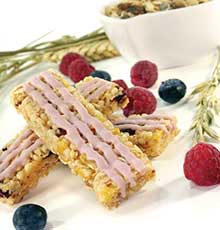 Yogurt Powder Functions in Multiple Applications
Yogurt Powder Functions in Multiple Applications
Yogurt powders impart a yogurt–dairy flavor to food applications and are becoming increasingly popular for use in beverages, confections, and dips as well as being promoted as a nutritional supplement. The U.S. Dairy Export Council cites a number of different uses for yogurt powders in product concepts like a yogurt-dipped peach snack bar, raspberry yogurt smoothie mix, strawberry fruit snack, and chocolate cherry chew. Consumers will also find yogurt powder used in coatings for treats for dogs and in non-food applications like cosmetics, particularly lotions. The powders are typically produced by adding cultures to nonfat milk, letting the product reach a specified pH, and drying the product, and can be blended with cultured nonfat milk, cultured whey, cultured whey protein concentrate, cultured dairy solids, nonfat dry milk, whey powder, lactic acid, and naturally derived or artificial flavors, according to the U.S. Dairy Export Council. While the overall flavor of yogurt powder is that of cultured dairy, it can vary from one yogurt powder to another depending on the cultures that were used and the pH level of the product before it was dried.
One of the more common uses for yogurt powder in the food industry is as an ingredient in coatings for confections and other products. Grande Custom Ingredients, Lomira, Wis. (www.grandecig.com), utilized its Grande Grade A Yogurt Powder Y45 in a yogurt coating for pretzels served at its booth during the 2013 IFT Annual Meeting & Food Expo. This is one of two yogurt powders the company manufactures: Y45 has a pH of 4.5 and a tart yogurt flavor, and Y50 has a pH of 5.0 with a mild, tart, milky flavor. Product developers can use the yogurt powders with starches and hydrocolloids in formulations to enhance creaminess in the finished product.
Cultures Provide Health and Safety Benefits
Researchers at the Agriculture University of Athens visited small yogurt producers and families around the Aegean Sea to learn about their Greek yogurt recipes and the cultures used as well as sample the homemade yogurt products. The information they learned led to the discovery of the culture used in SoGreek yogurt cultures, which debuted in the fall of 2013, from Chr. Hansen, Hørsholm, Denmark (www.chr-hansen.com).
The SoGreek ingredients contain blends of probiotics from Chr. Hansen, including BB-12® (Bifidobacterium animalis ssp. Lactis), and the culture discovered in Greece, which was isolated from an artisanal Greek yogurt made in Crete 20 years ago. There are six culture blends available in the SoGreek range. YoFlex ® SoGreek S1, YoFlex SoGreek S2, and nu-trish® BY SoGreek S1 are for use in strained yogurt while YoFlex SoGreek F1, YoFlex SoGreek F2, and nu-trish BY SoGreek F1 are for use in fortified yogurt. The nu-trish BY SoGreek cultures contain high cell counts of Chr. Hansen's probiotic BB-12 strain, which according to the company, has demonstrated benefits on gastrointestinal health through human, in vitro, and animal studies.
The company created all of the culture blends under the SoGreek banner to help manufacturers produce Greek-type yogurt using either separation technology or milk powder fortification. "To our knowledge we are the first to globally launch an authentic Greek culture for Greek yogurt, which is a segment that has far from peaked," states Morten Boesen, Marketing Manager at Chr. Hansen.
What's more, the company indicates that its SoGreek cultures address a number of trends of importance to consumers and manufacturers. Consumers demand yogurt products that taste good and have a smooth texture, and they also want authentic products. There is a growing interest in probiotics and their health effects, and yogurts made with the SoGreek cultures can deliver high probiotic cell counts, reports Chr. Hansen. On the processing side, the SoGreek cultures are said to be formulated to work in the separation and fortification production processes used in Greek yogurt manufacturing. Finally, some consumers are demanding short ingredient lists with ingredients that they can recognize, and product developers are formulating with such ingredients. Chr. Hansen promotes that using SoGreek cultures will allow manufacturers to list milk and cultures on the label without additives like starch and others.
--- PAGE BREAK ---
This article so far has presented information about some of the ingredients used in yogurt applications that can help improve texture, boost protein levels, provide additional health benefits, and more. DuPont Nutrition & Health, New Century, Kan. (www.dupont.com), offers a range of protective culture ingredients that address the importance of food safety, and it recently debuted a new generation of cultures in its Holdbac™ YM cultures range of ingredients called Holdbac YM Plus.
Citing a Danisco 2011 global survey, DuPont stresses that both consumers and manufacturers are concerned with dairy waste because it contributes to the overall amount of food waste that is generated and affects the repurchase rate of dairy foods. Manufacturers are continually searching for ingredient and processing solutions to help them increase the shelf life of finished products and lead to less product waste during manufacturing, shipping, and storage, a lower amount of product returns from retail, and more consumer satisfaction.
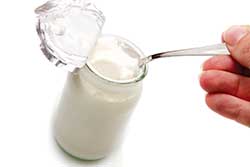 DuPont's Holdbac YM Plus ingredients are a blend of patented strains of Propionibacterium and Lactobacillus that are said to inhibit a wider range of yeast and mold contaminants in fermented dairy products while controlling off-flavors associated with yeast development, improving the control of yeast at 10°C, allowing for the use of less heat treatment, and not affecting the taste and texture of the finished yogurt product. The company adds that tests have shown the Holdbac ingredients to be as effective as potassium sorbate.
DuPont's Holdbac YM Plus ingredients are a blend of patented strains of Propionibacterium and Lactobacillus that are said to inhibit a wider range of yeast and mold contaminants in fermented dairy products while controlling off-flavors associated with yeast development, improving the control of yeast at 10°C, allowing for the use of less heat treatment, and not affecting the taste and texture of the finished yogurt product. The company adds that tests have shown the Holdbac ingredients to be as effective as potassium sorbate.
The Holdbac cultures are easy to use; yogurt manufacturers, for example, add the Holdbac YM Plus culture to the milk and starter culture and then proceed as usual in the yogurt manufacturing process. In addition to the benefit of ease of use, the cultures also offer manufacturers the ability to claim a longer product shelf life and label the cultures as simply "cultures" without the use of chemical preservatives.
Yogurt differs around the world based on consumer preferences for texture, taste, and inclusions as well as the ingredients that manufacturers use to make yogurt. In the United States, most consumers think of yogurt as a sweet food often fruit-flavored and brightly colored that is eaten out of a small handheld cup or spooned into a bowl and topped with granola. But yogurt is a versatile food that can be eaten on its own or used as a base for other foods and beverages like sauces and smoothies. Even the flavor of yogurt is used as an ingredient to flavor such things as coatings on inclusions and confections. Market research shows that many consumers enjoy yogurt, and product developers are meeting this demand by producing a number of yogurt and yogurt-based products. Ingredient innovations for yogurt and yogurt-based products will continue to evolve as consumer preferences for flavors and textures change and as consumers become more accustomed to new applications for this cultured dairy product.
Next month's Ingredients section will explore the latest developments in naturally derived colorings.
--- PAGE BREAK ---
What's New with Yogurt Products
The following commercial products available in grocery stores and other retail outlets and product concepts developed for various food industry expos illustrate the versatility of yogurt for use both as a food and as an ingredient.
• An instant mix for making frozen yogurt, PreGel Happy Yo Super Sprint, features Yoggi 30® and GanedenBC30 probiotics from Ganeden Biotech, Mayfield Heights, Ohio (www.ganedenbiotech.com). GanedenBC30 is a spore-forming probiotic bacterium whereby the spore protects the contents of the inside of the cell from heat and pressure of manufacturing, the rigors of shelf life, and the acid and bile in the digestive tract.
• David Michael & Co., Philadelphia, Pa. (www.dmflavors.com), exhibited tzatziki-flavored Greek yogurt sauce on Greek chicken sliders, raspberry rooibos tea-flavored frozen Greek yogurt, and pear-flavored frozen Greek yogurt at the 2013 IFT Annual Meeting & Food Expo.
• Peruvian dairy company Grupo Gloria's PRO Defensis drinkable yogurt product combines probiotics and Wellmune WGP, a proprietary baker's yeast beta 1,3/1,6 glucan for boosting immune cells, from Biothera, the Immune Health Company, Eagan, Minn. (www.biothera.com).
• Yogurt is often used as a condiment or in ingredient recipes for some Indian foods. Griffith Laboratories, Alsip, Ill. (www.griffithlaboratories.com), has captured the tart and creamy flavors of yogurt and blended them with other flavors of classic Indian dishes in some of its seasoning blends like New Delhi Topical, Bengal Topical, and Tandoori Marinade Seasoning.
• FONA International, Geneva, Ill. (www.fona.com), mixed a seasoning blend with Greek yogurt to create a banana-nut-honey sweet Greek yogurt dip/spread product concept for sampling at the 2013 IFT Annual Meeting & Food Expo.
• Vilkyškių has produced a yogurt made with quince, pumpkin, and cereal grain inclusions. The product is available in Poland.
• While Siggi's Dairy offers its Siggi's® skyr-type yogurt in consumer-favorite flavors like strawberry and blueberry, it also features more daring flavor combinations like mango and jalapeño and orange and ginger.
• A Thai peanut Greek yogurt dip featured flavors of ginger, roasted peanut butter, and black garlic from Sensient Flavors LLC, Hoffman Estates, Ill. (www.sensientflavors.com). Offered for sampling by the company at the 2013 IFT Annual Meeting & Food Expo, the dip illustrated how the tangy flavor of Greek yogurt combines well with spicy–sweet flavors characteristic in Thai cuisine.
• Cacique offers its Yonique drinkable low-fat yogurts in five fruit varieties (guava, mango, piña colada, strawberry, and strawberry-banana) and three made with wheat bran cereal (pecan, prune, and strawberry-banana).
• Chicory root contains inulin, a prebiotic that resists enzymatic digestion and acts as a sugar and fat replacer and fiber agent. At the 2013 IFT Annual Meeting & Food Expo, Sensus America Inc., Lawrenceville, N.J. (www.sensus.us), demonstrated some of these functionalities of its Frutalose® SF75 chicory root fiber in a Greek soft-serve frozen yogurt product concept.
• As a treat for the Christmas season, consumers had a limited time to enjoy Mocha Mint and Peppermint Bark Low-Fat Yogurts from Yoplait. Other limited-time yogurt flavors the company has offered were piña colada and cosmopolitan, without the alcohol, of course.
• Greek yogurt continues its reach into other product categories like frozen novelties. Adonia by Ciao Bella Greek Frozen Wild Blueberry Yogurt Sticks is high in protein and is made with live and active cultures.
• Squeezable pouches and kid-friendly flavors are ways to entice children to consume yogurt. Take the cotton candy-flavored YoYummy refrigerated yogurt pouch from Green Mountain Creamery, for example. Drinkable yogurts are also popular with children. Stonyfield has combined strawberry and banana purees with carrot puree and raspberry and strawberry purees with sweet potato puree in its YoKids Smoothies.
• Michel et Augustin combines coffee into drinking yogurt in its Vach Frappée au Café de Colombie (drinking yogurt with Colombian coffee) available in France. It has also formulated a drinking yogurt with raspberry and mint for the Belgian market.
• Consumers in Germany can enjoy rhubarb fruit paired with vanilla in Desira Purer Gensuss Trink Joghurt Rhabarber Vanille (rhubarb vanilla drinking yogurt).
www.ift.org
Members Only: Read more about yogurt online at www.ift.org. Type the keyword into our search box at the upper right side of our home page.
 Karen Nachay
Karen NachaySenior Associate Editor
[email protected]
References
Mintel. 2013. Yogurt and Yogurt Drinks—U.S.—August 2013 Executive Summary. Mintel, Chicago, Ill.
USDEC. 2009. U.S. Whey Ingredients in Yogurt and Yogurt Beverages Applications Monograph Yogurt. U.S. Dairy Export Council, Arlington, Va.
